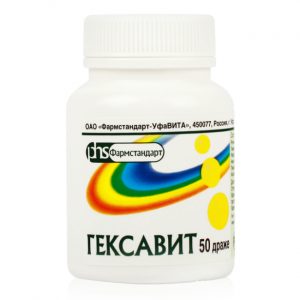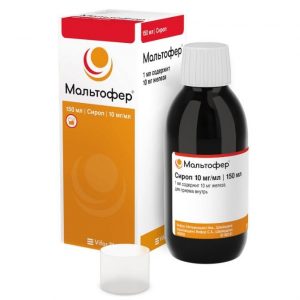Description
Pharmacological action of
Glucose enhances redox processes in the body, improves antitoxic function of the liver, enhances myocardial contractility, is a source of easily digestible carbohydrates.
Pharmacodynamic properties of 5% and 10% dextrose solutions are similar to those of glucose, the main energy source of cellular metabolism.
5% dextrose solution is an isotonic solution with an osmolarity of about 278 mOsm / l. The calorie intake of a 5% dextrose solution is 200 kcal / l. A 10% dextrose solution is a hypertonic solution with an osmolarity of about 555 mOsm / L. The calorie intake of a 10% dextrose solution is 400 kcal / l.
In the framework of parenteral nutrition, 5% and 10% dextrose solutions are administered as a source of carbohydrates (separately or as part of parenteral nutrition, if necessary). 5% and 10% dextrose solutions make up for fluid deficiency without the simultaneous introduction of ions. Dextrose, entering the tissue, phosphorylates, turning into glucose-6-phosphate, which is actively involved in many parts of the body’s metabolism.
When using dextrose solutions to dilute and dissolve parenteral drugs, the pharmacodynamic properties of the solution will depend on the substance added.
Pharmacokinetics:
Glucose is metabolized in two different ways: anaerobic and aerobic.
Dextrose, breaking down into pyruvic or lactic acid (anaerobic glycolysis), is metabolized to carbon dioxide and water with the release of energy.
When using a dextrose solution to dilute and dissolve parenteral drugs, the pharmacokinetic properties of the solution will depend on the substance added.
Indications of
as a source of carbohydrates (alone or as part of a parenteral diet if necessary)
for rehydration in case of fluid loss, especially in patients with a high need for carbohydrates
for dilution and dissolution of parenteral medications
for the prevention and treatment of hypoglycemia.
Use during pregnancy and lactation
10% glucose solution during pregnancy and lactation can be used only under the condition of physician control of fluid balance in the body and electrolyte balance, which must be within physiological limits. When using the solution as a transport of other drugs, the effect of these additional drugs during pregnancy and lactation should be evaluated.
Special instructions
Since patients with diabetes mellitus, kidney failure, or are in critical condition, glucose tolerance (dextrose) may be impaired, their clinical and biological parameters, in particular the concentration of electrolytes in blood plasma, should be carefully monitored the number of magnesium or phosphorus, the concentration of glucose in the blood. In the presence of hyperglycemia, the rate of administration of the drug should be adjusted or short-acting insulin should be prescribed.
Usually glucose is completely absorbed by the body (normally it is not excreted by the kidneys), therefore, the appearance of glucose in the urine can be a pathological sign.
In the case of prolonged administration or use of dextrose in high doses, it is necessary to control the concentration of potassium in the blood plasma and, if necessary, introduce additional potassium to avoid hypokalemia.
In episodes of intracranial hypertension, careful monitoring of blood glucose concentration is necessary.
The use of dextrose solutions can lead to hyperglycemia. Therefore, they are not recommended to be administered after an acute ischemic stroke, since hyperglycemia is associated with increased ischemic damage to the brain and prevents recovery.
Particularly careful clinical monitoring is required at the start of intravenous administration.
For rehydration therapy, carbohydrate solutions should be used in combination with electrolyte solutions to avoid electrolyte imbalance (hyponatremia, hypokalemia).
It is necessary to control the concentration of glucose and the content of electrolytes in the blood, water balance, as well as the acid-base state of the body.
The solution should be inspected before use. Use only a clear solution without visible impurities and in the absence of damage to the packaging. Enter immediately after connecting to the infusion system.
The solution should be administered using sterile equipment in compliance with aseptic and antiseptic rules.
To prevent air embolism, remove air from the infusion system with a solution.
Do not connect containers in series to avoid air embolism, which may result from air being drawn in from the first container until the solution has been introduced from the second container. Intravenous solution delivery contained in soft plastic containers, under increased pressure in order to increase the flow rate, it can lead to an air embolism if the residual air in the container is not completely removed before administration. Using an intravenous vent system can lead to air embolism with an open vent. Soft plastic containers with such systems should not be used. Added substances can be administered before infusion or during infusion through the injection site (if there is a special port for drug administration). The addition of other drugs to the solution or a violation of the administration technique can cause fever due to the possible ingestion of pyrogens. If adverse reactions develop, infusion should be stopped immediately. When adding other drugs before parenteral administration, it is necessary to check the isotonicity of the resulting solution. Complete and thorough mixing under aseptic conditions is mandatory. Solutions containing additional substances should be used immediately, their storage is prohibited. With the introduction of additional nutrients, the osmolarity of the resulting mixture should be determined before the start of the infusion. The resulting mixture must be injected through a central or peripheral venous catheter depending on the final osmolarity. The compatibility of additionally administered drugs must be evaluated before they are added to the solution (similar to the use of other parenteral solutions). The assessment of the compatibility of additionally administered drugs with the drug is the responsibility of the physician. It is necessary to check the resulting solution for a color change and / or the appearance of a precipitate, insoluble complexes or crystals. You should study the instructions for the use of added drugs. From a microbiological point of view, a diluted preparation should be used immediately. The exception is breeding prepared under controlled and aseptic conditions. Otherwise, after preparation of the solution, the terms and conditions of its storage until administration are the responsibility of the user. Children In newborns, especially premature or low birth weight babies, the risk of developing hypo- or hyperglycemia is increased, therefore, during the intravenous administration of dextrose solutions, careful monitoring of blood glucose concentration is necessary to avoid long-term undesirable consequences. Hypoglycemia in newborns can lead to prolonged convulsions, coma, and brain damage. Hyperglycemia is associated with intraventricular hemorrhage, delayed bacterial and fungal infectious diseases, retinopathy, premature necrotizing enterocolitis, bronchopulmonary dysplasia, prolonged hospitalization and mortality. In order to avoid a potentially fatal overdose of intravenous drugs in newborns, special attention should be paid to the method of application. When using a syringe pump for intravenous administration of drugs to newborns, the container with the solution should not be left attached to the syringe. When using an infusion pump, before removing the system from the pump or turning it off, it is necessary to close all the clamps of the system, regardless of whether there is a device in the system, obstructing the free flow of fluid. Intravenous infusion devices and other equipment for drug administration should be regularly monitored. If the product contains dextrose derived from corn, the use of the drug is contraindicated in patients with known intolerance to corn or corn products, as The following manifestations of hypersensitivity are possible: anaphylactic reactions, chills, and fever. For preparations in containers: Dispose of containers after a single use. Every unused dose should be disposed of. Do not reuse partially used containers.
Composition
1 ml
dextrose 0.10 g
Excipients: sodium chloride 0.00026 g, hydrochloric acid solution 0.1 M to pH 3.0 – 4.1, water d / and up to 1 ml.
Dosage and administration
Dextrose solution for infusion is administered intravenously (drip). The drug is usually injected into a peripheral or central vein. The concentration and dose of the injected solution depend on the age, body weight and clinical condition of the patient. The use of the drug should be carried out under regular medical supervision. Clinical and biochemical parameters, in particular the concentration of glucose in the blood, as well as the water-salt balance, should be carefully monitored.
Side effects
Adverse reactions (HP) are grouped by system and organ according to the MedDRA Dictionary and WHO Classification of the Development Frequency of HP:
Very often (? 1/10), often (? 1/100 to
On the part of the immune system: frequency is unknown – anaphylactic reactions, hypersensitivity.
On the part of metabolism and nutrition: frequency is unknown – disturbance of water-electrolyte balance (hypokalemia , hypomagnesemia, hypophosphatemia), hyperglycemia, hemodilution, hypervolemia, dehydration.
From the vessels: unknown frequency – venous thrombosis, phlebitis.
From the skin and subcutaneous tissues: unknown frequency – increased sweating. urinary urinary
x ways: frequency unknown – polyuria
General disorders and disorders at the injection site: frequency unknown – chills, fever, infection at the injection site, irritation at the injection site, extravasation, pain at the injection site.
Laboratory and instrumental data: frequency unknown – glucosuria.
Adverse reactions may also be associated with a drug that has been added to the solution. The likelihood of other adverse reactions depends on the properties of the particular drug being added.
If adverse reactions occur, the solution should be discontinued.
Drug Interactions
The combined use of catecholamines and steroids reduces the absorption of dextrose (glucose).
When mixed with other drugs, they must be visually checked for incompatibility.
To dilute or dissolve other drugs, the drug should be used only if there are instructions for dilution with a dextrose solution in the instructions for use for this drug.
In the absence of information on the compatibility of the drug should not be mixed with other drugs.
Before adding any medicine, make sure that it is soluble and stable in water in the pH range of the drug.
After adding a compatible drug to the preparation, the resulting solution should be administered immediately.
Medicines with a known incompatibility cannot be used.
When dextrose solutions are administered through the same infusion system as for blood transfusion, there may be a risk of hemolysis and thrombosis.
Overdose of
Symptoms:
Prolonged infusion of the drug can lead to hyperglycemia, glucosuria, hyperosmolarity, osmotic diuresis and dehydration. Rapid infusion can create fluid accumulation in the body with hemodilution and hypervolemia, and if the body’s ability to oxidize glucose is exceeded, rapid administration can cause hyperglycemia. There may also be a decrease in the content of potassium and inorganic phosphate in the blood plasma.
When using a dextrose solution for infusion to dilute and dissolve other drugs for intravenous administration, the clinical signs and symptoms of an overdose may be related to the properties of the drugs used.
Treatment:
If symptoms of an overdose occur, suspend administration of the solution, assess the patient s condition, administer short-acting insulin, and, if necessary, conduct supportive symptomatic therapy.
Storage conditions
Store at a temperature of +5 ° C to +30 ° C.
The Expiration of
is 3 years.
Deystvuyuschee substances
Dextrose
Pharmacy terms of delivery
Prescription
Form of Treatment
simply entails dlya infusing
MEDPOLIMER, Russia


